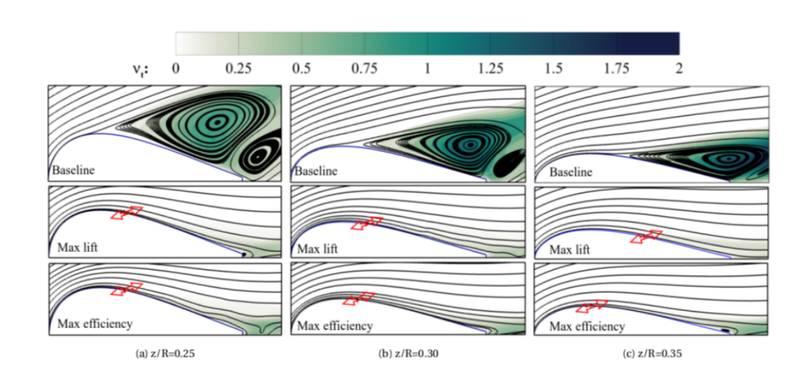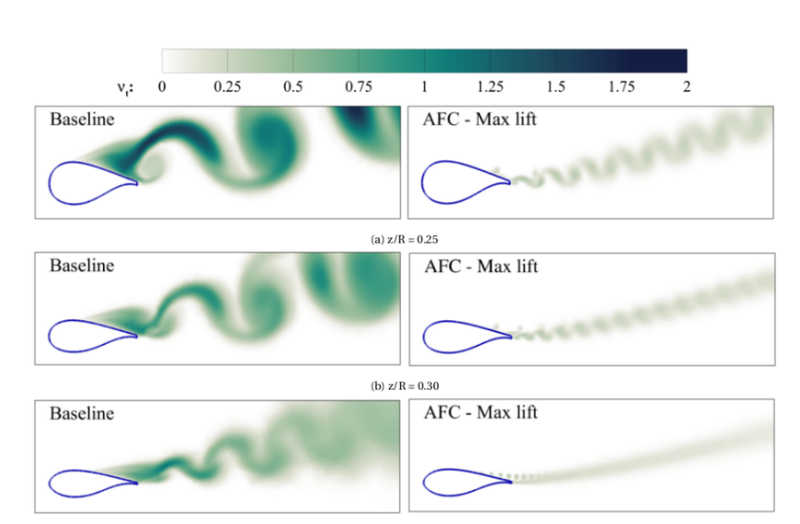New Generation of HAWT. Smart or intelligent wind turbines. MKT2024/0194_E
Between the cut-in and rated speeds, the new generation of horizontal axis wind turbines will have implemented active flow control technology to reattach the boundary layer in all airfoils along the blade and under all WT operating conditions. The blade tip vortices will also be removed/minimized using the AFC technology. Minimizing vortical structures along the blade and tip will increase turbine power, reduce dynamic forces and noise, and allow for closer positioning of consecutive turbines. Ref. MKT2024/0194_E
New Generation of HAWT. Smart or intelligent wind turbines. MKT2024/0194_E
Between the cut-in and rated speeds, the new generation of horizontal axis wind turbines will have implemented active flow control technology to reattach the boundary layer in all airfoils along the blade and under all WT operating conditions. The blade tip vortices will also be removed/minimized using the AFC technology. Minimizing vortical structures along the blade and tip will increase turbine power, reduce dynamic forces and noise, and allow for closer positioning of consecutive turbines. Ref: MKT2024/0194_E
El repte/The challenge
- It is the first time the boundary layer separation location, its associated vortex shedding frequency and the lift and drag coefficients peak to peak amplitudes of a given wind turbine blade under several operating conditions are to be determined.
- It is the first time the AFC technology is to be implemented to wind turbines after optimizing the five AFC parameters in each section where the boundary layer is separated. This optimization needs to be done at different wind speeds.
- It is the first time that AFC is to be implemented on the tip of wind turbine blades to reduce/minimize the tip vortical structures. The study needs to be repeated for different wind speeds.
- AFC applications to airfoils at very high Reynolds numbers, of an order of magnitude around 12 million are completely novel, there are no previous studies explaining which FC technology may be effective at these very high Reynolds numbers.
La tecnologia/The technology
Active flow control (AFC) technology can be implemented using different actuators, Fluidic Oscillators (FO), Synthetic Jets (SJ) also called zero Net Mass Flow Actuators (ZNMFA), Plasma Actuators (PA), Constant Blowing (CB) and Constant Sucking (CS). The use of periodic forcing appears to interact with the boundary layer natural instabilities, and so it requires less energy to delay the boundary layer separation point; this characteristic along with the fact that synthetic jets are capable of generating large momentum coefficients which should be sufficient to delay the separation of the boundary layer. In the case of small and medium turbines, where the local Reynolds number is smaller than the one associated to large wind turbines, the use of plasma actuators instead of synthetic jets shall be evaluated.
Avantatges innovadores/Innovative advantages
All what we are planing to do is novel; perhaps the initial novelty resides in initially obtaining the boundary layer separation points from all blade sections under different operating conditions of wind turbines. The second major novelty consists of optimizing the five active flow control parameters in all sections where the boundary layer is separated. This will allow to implement the AFC technology using the minimum energy to delay the separation of the boundary layer. Such an implementation will increase the power generated by the wind turbine, will decrease the vortical structures as well as the dynamic forces generated by the turbine, will decrease the noise generated by the turbine and will allow consecutive wind turbines to be placed more close together. Another important novelty consists of reducing/minimizing the vortical structures generated on the blade tips at different operating conditions. Tip vortical structures dissipate rather far away from the WT
(about 10 to 15 times the WT diameter), and they also generate dynamic forces.
Fase actual de desenvolupament/Current stage of development
Aplicacions i mercat objectiu/Applications and target market
The technology described is applicable to all horizontal axis wind turbines and is to be applied along the radial direction of the blades and at the tip of the blade. The AFC implementation along the blade radial direction is completely different from the one to be used at the blade tip. The target market is all Horizontal axis wind turbine manufacturers.

Streamlines of temporal average velocity field and contours of turbulence velocity at z/R: 0.25, 0.30 and 0.35.

Wake comparison between the baseline and the maximum lift cases for the three airfoils considered. The wake is presented ad a function of the turbulence viscosity vt evolution
Oportunitats de negoci/Business opportunity
Tecnologia disponible per a ser llicenciada/Technology available to be licensed
Estat de la propietat intel·lectual i industrial/Intelectual property status
Patent sol·licitada/Applied patent
Contacte/Contact
Servei de Gestió de la Innovació
T. +34 934 13 76 23
gestio.innovacio@upc.edu